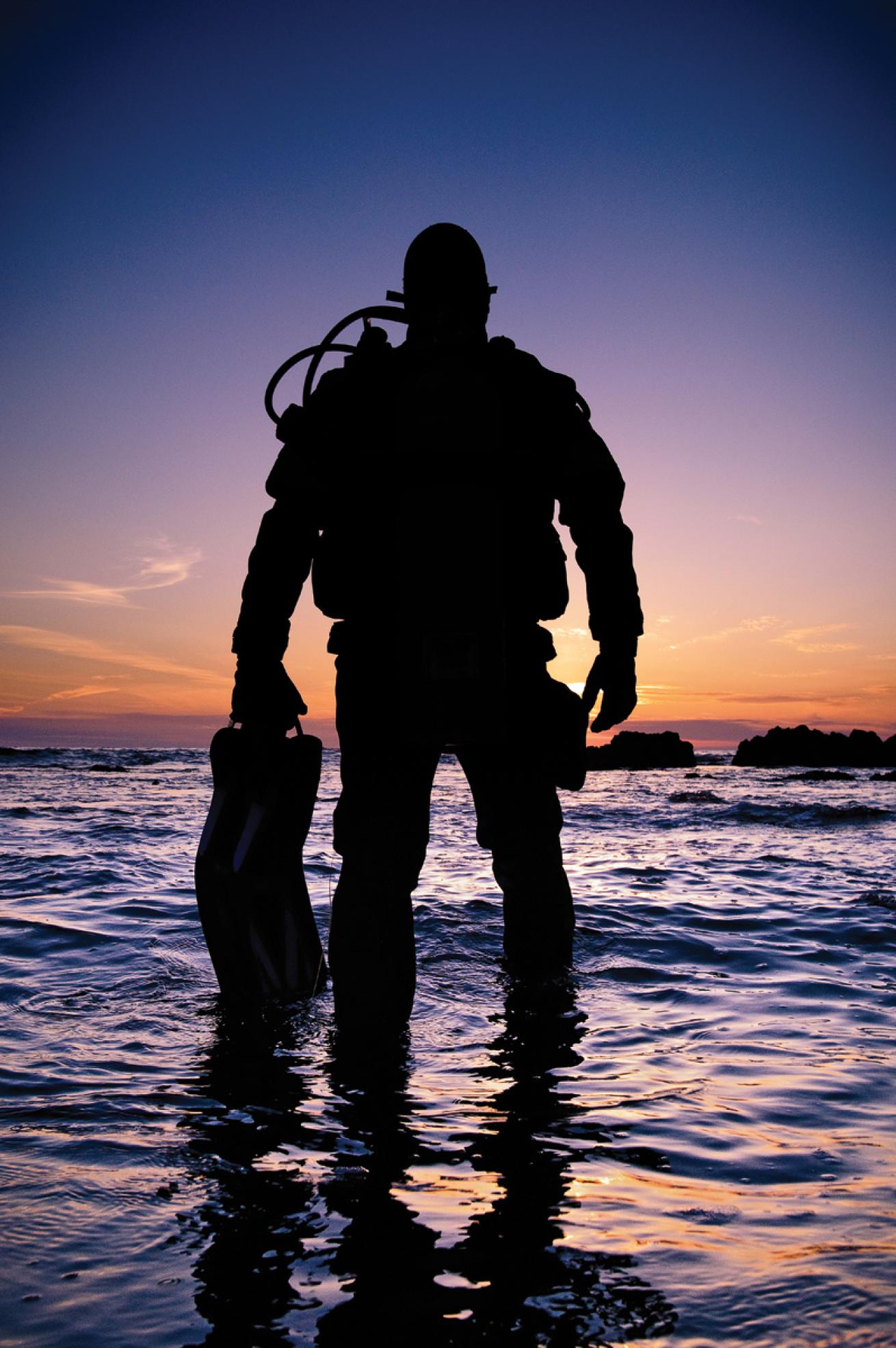6 Tips for Better Shore Diving
To ease the learning curve, I asked Joe Raemer, an assistant instructor at Southern California institution Dive N’ Surf, to share a few of his best practices. The veteran of more than 700 beach dives has been exploring the near- shore reefs of the Golden State since 1997 and guiding guests into the surf as a professional since 2001.
These are some of the trade secrets he shared with me:
SURVEY THE SCENE
Practicing solid situational awareness is a key for any safe dive plan, but when adding the more unpredictable elements of a shore entry — pounding surf, sudden drop-offs, hidden rocks and other challenges — being hyperaware of your surroundings is even more important. “I know of no book or class that can give you all you need to know to make the necessary assessments,” says Raemer, who combines careful observation with advice from divers familiar with current local conditions. “Always consider that borderline ‘safe’ conditions can change while you’re submerged, so be sure to check tides, wind and swell forecasts beforehand. And listen to your inner voice, because a shore diver must always be willing to say, ‘We’re not getting wet today’ — no matter how much you want to make the dive.”
LOCK DOWN YOUR RIG
Even small surf and light surge can wreak havoc on your kit, so be prudent in securing all your tools. “Don’t hold any gear, like dive lights or cameras, just in your hands,” Raemer says. “And don’t hold your fins in your fists, but rather loop them over your wrists so if you slip and stick out your hand to stop your fall, you won’t lose them.”

Dive Hacks
These simple tips will make your next shore dive a piece of cake!
Jason Bradley
Shore diving is the ultimate in scuba freedom. With no dawn-cracking boat schedules or draconian limits on bottom time, this diving style appeals to the most adventurous of our tribe. In destinations such as Bonaire, California, Hawaii, Philippines and Grand Cayman, there are world-class reefs and wrecks within a few fin kicks of the beach. But making a dive from shore requires an entry strategy, some surf-specific tactics and a healthy sense of self-reliance.
BRACE FOR THE PUNCH
Waves are the main barrier of entry into the underwater world. “My best advice — be prepared to get knocked down, slip or fall,” says Raemer. “Remember to hold your mask firmly on your face with an open palm when going through a wave. If you’re wearing a hood, put on your mask first, then pull it on over your mask strap, so your mask can’t be yanked off. And always enter and exit the water with your mask on and your regulator in your mouth, so if you get knocked down, you will still be able to breathe and see.”
DUCK THE WAVE
Even when faced with what looks like a tsunami, there are ways to avoid a total wipeout. “Most of a wave’s force rides along and above the surface, so if a diver can get under a wave, most of the power will pass right over them,” Raemer explains. “When coming face to face with a breaking wave, lower your body as much as possible by bending your knees or even going into a kneeling posture. Try to keep a firm footing and lean slightly into the wave, so when it passes over, the back suction from the wave’s forward momentum can return you to a standing position. With a little practice, even large waves can be safely bypassed using this method.”
STEP CAREFULLY
Because wave action clouds visibility, it can be difficult to identify potential hazards. Rocky entries create further complications, so an added dose of precaution pays off. “Often slippery algae will grow on rocks along the water’s edge,” says Raemer. “And rocks can move underfoot, so always test your footing before committing to a step; remember, with all your gear donned, it’s easier to lose your balance.”
EXIT GRACEFULLY
Conventional wisdom advises to never turn your back on the ocean — so don’t. “Employ a sideways step so you can easily look forward and backward,” Raemer says. “In the event you do fall and can’t get up, keep your regulator in your mouth and crawl out. It won’t look graceful or cool, but you’ll get out safely.”
To ease the learning curve, I asked Joe Raemer, an assistant instructor at Southern California institution Dive N’ Surf, to share a few of his best practices. The veteran of more than 700 beach dives has been exploring the near- shore reefs of the Golden State since 1997 and guiding guests into the surf as a professional since 2001.
These are some of the trade secrets he shared with me:
SURVEY THE SCENE
Practicing solid situational awareness is a key for any safe dive plan, but when adding the more unpredictable elements of a shore entry — pounding surf, sudden drop-offs, hidden rocks and other challenges — being hyperaware of your surroundings is even more important. “I know of no book or class that can give you all you need to know to make the necessary assessments,” says Raemer, who combines careful observation with advice from divers familiar with current local conditions. “Always consider that borderline ‘safe’ conditions can change while you’re submerged, so be sure to check tides, wind and swell forecasts beforehand. And listen to your inner voice, because a shore diver must always be willing to say, ‘We’re not getting wet today’ — no matter how much you want to make the dive.”
LOCK DOWN YOUR RIG
Even small surf and light surge can wreak havoc on your kit, so be prudent in securing all your tools. “Don’t hold any gear, like dive lights or cameras, just in your hands,” Raemer says. “And don’t hold your fins in your fists, but rather loop them over your wrists so if you slip and stick out your hand to stop your fall, you won’t lose them.”

Jason BradleyDive Hacks
These simple tips will make your next shore dive a piece of cake!
Shore diving is the ultimate in scuba freedom. With no dawn-cracking boat schedules or draconian limits on bottom time, this diving style appeals to the most adventurous of our tribe. In destinations such as Bonaire, California, Hawaii, Philippines and Grand Cayman, there are world-class reefs and wrecks within a few fin kicks of the beach. But making a dive from shore requires an entry strategy, some surf-specific tactics and a healthy sense of self-reliance.
BRACE FOR THE PUNCH
Waves are the main barrier of entry into the underwater world. “My best advice — be prepared to get knocked down, slip or fall,” says Raemer. “Remember to hold your mask firmly on your face with an open palm when going through a wave. If you’re wearing a hood, put on your mask first, then pull it on over your mask strap, so your mask can’t be yanked off. And always enter and exit the water with your mask on and your regulator in your mouth, so if you get knocked down, you will still be able to breathe and see.”
DUCK THE WAVE
Even when faced with what looks like a tsunami, there are ways to avoid a total wipeout. “Most of a wave’s force rides along and above the surface, so if a diver can get under a wave, most of the power will pass right over them,” Raemer explains. “When coming face to face with a breaking wave, lower your body as much as possible by bending your knees or even going into a kneeling posture. Try to keep a firm footing and lean slightly into the wave, so when it passes over, the back suction from the wave’s forward momentum can return you to a standing position. With a little practice, even large waves can be safely bypassed using this method.”
STEP CAREFULLY
Because wave action clouds visibility, it can be difficult to identify potential hazards. Rocky entries create further complications, so an added dose of precaution pays off. “Often slippery algae will grow on rocks along the water’s edge,” says Raemer. “And rocks can move underfoot, so always test your footing before committing to a step; remember, with all your gear donned, it’s easier to lose your balance.”
EXIT GRACEFULLY
Conventional wisdom advises to never turn your back on the ocean — so don’t. “Employ a sideways step so you can easily look forward and backward,” Raemer says. “In the event you do fall and can’t get up, keep your regulator in your mouth and crawl out. It won’t look graceful or cool, but you’ll get out safely.”










